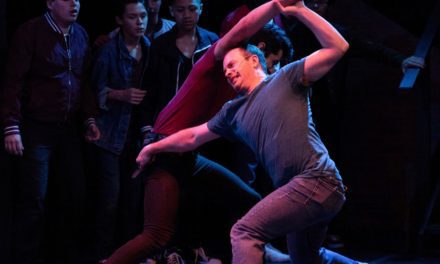SALT LAKE CITY – Utah loves its Shakespeare. From the Utah Shakespeare Festival to any number of local community productions, UTBA has reviewed over 20 Shakespeare productions since October last year. And there have been quite a variety of shows. The Sting and Honey Company brings a seldom produced, but very moving Shakespeare play, The Winter’s Tale. I only wish that their production lived up to the promise of this play.

Show closes September 29, 2012.
The Winter’s Tale involves friendship, betrayal, death, deception, disguise, love, and—finally—redemption. This is often called one of Shakespeare’s “problem” plays, since the first three acts seem to be dramatic and tragic, while the last two acts are much lighter in mood, and the play ends happily. While this may be a problem for classifying the play, many of Shakespeare’s plays mix the tragic and comic, and this is especially true of his later works, where The Winter’s Tale falls.
Sting and Honey has a visually beautiful production. The set (designed by Javen Tanner) was stark but beautiful. I am a huge fan of minimal sets in Shakespeare productions, and I felt this set held the promise of great things to come. The stage was painted white to look like marble, with a central platform, and steps in the back corner that led to a raised platform with the most amazing sculpted tree by Suzanne Conine. The costume design by Tara Lynn Tanner and Marissa Morton was visually interesting and had a very Elizabethan feel.
Director Javen Tanner created a very stylized production, beginning with a sort of tableau opening. The actors entered the stage in groups and took position around the stage, finally coming together to form an overall stage picture before the lights came on to full and the action began. This seemed to be a way to differentiate the courtly scenes in Sicilia from the more rustic scenes in Bohemia. While I understand and appreciate the attempt, the execution didn’t work for me. In theory it provides a visual distinction between the two worlds of the play, but in practice it seemed to slow the scene changes, and then was suddenly dropped later for no apparent reason. I didn’t make the connection until the action returned to the court for the final scene and this was again used.

Deena Marie Manzanares as Hermione.
And that seems to be the problem I had with the majority of the play. There seemed such promise from the outset, and while there are so many things in this production to admire, there so many things that fall short of expectations. My wife, who was my companion for the evening, said afterwards (and she will kill me for including this, but it seems appropriate), “After entering the theater and seeing the set, I was so excited for this production. And then it started.” The pacing in the first act is glacial. It seems the intention was to make the tragedy more meaningful by being so ponderous in emoting. This culminated in the Joan of Arc-like court scene, where only half the actors onstage seemed to be reacting to the events, regardless of whose side they chose.
Some of the “lesser” characters saved the first act from collapsing in on itself. In fact it was the characters of Camillo (Stephen Williams), Antigonus (Roger Dunbar), and Paulina (Kathryn Atwood) that kept the first act afloat. Williams delivered a very measured performance as a servant whose integrity leads him to betray his fealty and aid Polixenes to escape Leontes’ plot against his life. Dunbar gave a controlled performance as Antigonus, a man who is forced into performing acts that are beyond his nature; in the second act, he plays the polar opposite in Autolycus, a con artist of the first degree. Dunbar’s comedic timing is marvelous, particularly in his opening monologue near the top of the second act, and in the pickpocket scene with Daniel Anderson’s Clown. Kathryn Atwood gave such fire and passion to Paulina, particularly when confronting Leontes over his accusations of Hermione’s (Deena Marie Manzanares) supposed infidelity. And her small turn as Time at the top of Act Two was an inspired way to get the audience back from intermission and into the play once again.
This illustrates my frustration with this production. It is obvious that the cast is talented, including the young students from the Waterford School. I could see the evidence of a great passion for Shakespeare in the approach to the play, the set, the costumes, and the overall vision of the piece. But there are so many small things that just miss the mark that keep this review from being a full-hearted endorsement, and leave it as a lukewarm reception at best. First, there is the issue of boots. In the first half of the performance, the clomping around of the actors on stage was quite distracting, to put it mildly. Since this didn’t happen in the final scene, it leaves me wondering why it was so significant at the beginning. Also, I mentioned the sculpted tree that greets the audience from the stage as they enter the theater. It is an amazing work of art. But at the end of the play, when it is rotated, it appears that the statue of Hermione is embedded in the tree, which lessened the impact of the reveal of the statue. Characters constantly refer to the statue as stone; numerous lines reference it as stone. Why make it look like it is a part of the tree? Perhaps I’m too literal. I liked the reveal of turning the tree to bring forth the statue of Hermione, but to have her emerging from the tree seemed such a misstep. Another glaring error to me was in regards to how they handled what is perhaps Shakespeare’s most famous stage direction, “Exit, pursued by a bear.” It’s a most enigmatic stage direction. How do you fulfill it? Shadows? An actor in a bear costume? Without spoiling anything, I thought at first they had done a miraculous feat in staging this, only to have it obliterated by a 15 second tableau.
Perhaps the thing that brought about these missteps was the fact that the director was also the most prominent star and one of the more prominent secondary characters as well. Javen Tanner is a professional actor, and has worked in New York and with many companies around the country. He has taught acting at NYU’s Tisch School of the Arts and at BYU, but there are few artists that can truly shine as both star and director of a show. As I’ve said in this review, there are many masterful strokes in the direction of this play, but also so many missed or mistaken elements that the whole is diminished.
In the end, while this isn’t all that I had hoped for in The Winter’s Tale, it is a production worth seeing, if for no other reason than it is one of Shakespeare’s lesser performed gems, and for the amazing performances of Kathryn Atwood, Roger Dunbar, and Daniel Anderson. They truly are exciting to watch, and this remains a beautiful, if less than perfect, production.






